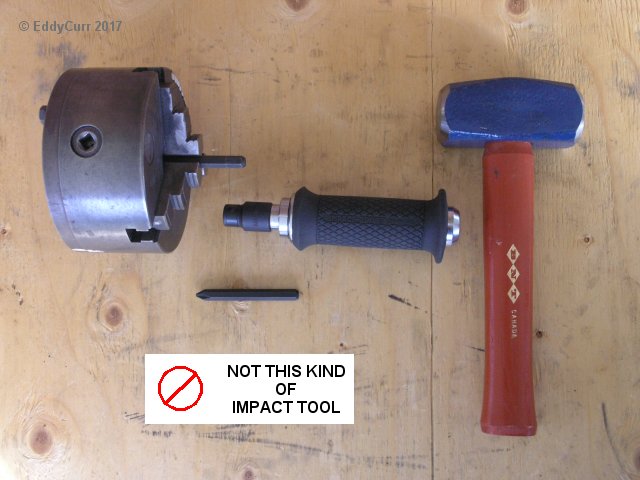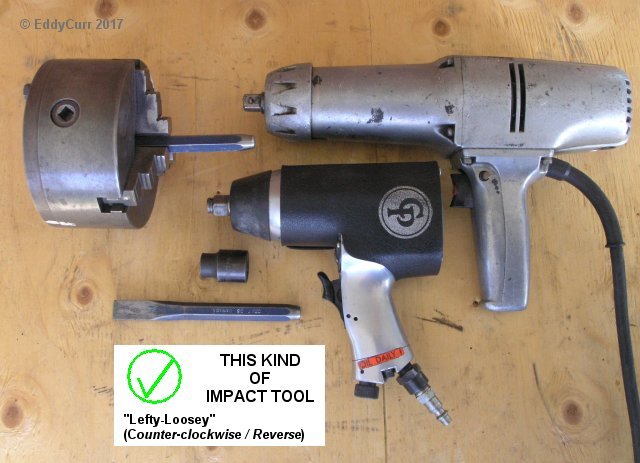Unstick ML7 chuck
How I did it
| Eddy Curr | 14/10/2017 02:52:22 |
| 39 forum posts | I second the (already acknowledged by OP) suggestion to tighten a piece of hex stock in the chuck jaws. I'll add that if such equipment is available, then you can consider applying a pnuematic or electric impact gun, fitted with a suitably sized socket, to the protruding end of the hex stock. (I am describing a proper impact tool, I have no experience using a hammer drill for the task - maybe one of those might suffice, too ?) Set the tool to turn in the appropriate direction, adjust its impact torque to the lowest setting. Use less air pressure than commonly specified for pnuematic impacts. There is no need to block rotation of the spindle. In my experience, a brief actuation of the tool will bring about the desired result. I've never done so, but if there is a concern about damage from the impact tool, consider making a torque-limiting adapter. Machine a groove down to a diameter that will shear at a figure you are comfortable with. Or make a 2-pc adapter held together w/ a shear pin. Pre-test/calibrate the adapter by using a torque wrench on a sample adapter held in a vise. |
| peter blair | 14/10/2017 02:54:49 |
| 34 forum posts 25 photos | Thanks for the suggestion Eddy but as noted earlier I tried this method without success!!!
|
| ega | 14/10/2017 09:13:50 |
| 2805 forum posts 219 photos | Posted by peter blair on 13/10/2017 16:31:13:
... On a different topic, has anyone made an adjustable carriage stop for the ML7? If so would you care to point me in the right direction or share with me? The Amateur's Lathe contains a design for a stop mounted to the right of the carriage; left-hand designs depend on whether a gearbox is fitted. |
| ega | 14/10/2017 09:27:57 |
| 2805 forum posts 219 photos | Eddy Curr: I very much like the idea of loosening the chuck by repeated blows without immobilising the spindle and will try this if the need arises. Instinctively, however, it would seem that the blows should be "radial" rather than axial and that a hammer tool (as opposed to the mechanic's air wrench) would be less suitable. |
| Ady1 | 14/10/2017 09:40:08 |
6137 forum posts 893 photos | The easiest route I've found on a Myford M series is to use the backgear A bit of wood on the bed (at a right angle) and a roundbar into a hole in the belt pulley A bit of pressure on the bar from left to right (moves pulley backwards about an inch or two) and the chuck unscrews itself Zero violence required I think the reason it works so well is because the 6:1 ratio (or so) of the backgear allows you a lot of control over how much pressure to apply (plus the block of wood gives you a decent 90 degree lever at the spindle nose) and the chuck is removed with the absolute minimum pressure necessary to achieve success Edited By Ady1 on 14/10/2017 09:55:06 |
| peter blair | 14/10/2017 14:53:51 |
| 34 forum posts 25 photos | Ady1, thanks for this. Can you provide anymore detail relating to the hole in the belt pulley? Did you drill it? How deep is it and what diameter? I see your sectional belt. This is what I plan to do should I ever need to replace mine. I'm a little afraid to take the bearings out to replace it. |
| larry Phelan | 14/10/2017 17:09:18 |
544 forum posts 17 photos | I too had this problem some years ago,but I managed to break a gear in the process. With this in mind,I would be very interested in that product called "Never Seize". Who makes it,who sells it ? I think that Ali clamp is a good idea,will make one up soon [before I break another gear !! ] The sheer hassle of replacing it !! |
| peter blair | 14/10/2017 19:24:14 |
| 34 forum posts 25 photos | Larry here is a shot of the material I use.
Here is a shot of it in place. I push the pin into the slot and have cut a small slot in the pin that I can use to gently pry it out of the grove when I'm done. Seems that it should work pretty well especially if the chuck is maintained as has been suggested. Of course my chuck is no longer stuck so I really haven't yet had a chance to 'test' it properly. |
| Ady1 | 15/10/2017 11:24:42 |
6137 forum posts 893 photos | Can you provide anymore detail relating to the hole in the belt pulley? There was already an oiler hole in my pulley of about 9mm, I use an 8mm bar If you are going to drill your own hole make sure the pulley casting is solid and not hollow at the drilling point GL Edited By Ady1 on 15/10/2017 11:25:05 |
| larry Phelan | 15/10/2017 11:31:10 |
544 forum posts 17 photos | Thanks Peter for your reply. I was unable to open your pictures,but I came across stuff yesterday which I think is much the same as your Never Seize. I will get a can of it,while also making an Ali clamp. |
| larry Phelan | 15/10/2017 11:35:21 |
544 forum posts 17 photos | Peter,sorry about this,but I have just found your picture of Never Seize !! You know what they say about OLD AGE ? Thanks again. |
| John McNamara | 15/10/2017 12:35:32 |
1377 forum posts 133 photos | Hi Regards
|
| Neil Wyatt | 15/10/2017 13:15:20 |
19226 forum posts 749 photos 86 articles | Posted by John McNamara on 15/10/2017 12:35:32:
Hi Surely that's just going to tighten the chuck up even more? |
| John McNamara | 15/10/2017 13:46:23 |
1377 forum posts 133 photos | Well spotted Gee Neil its been ten years since I had to do this. I think you are right the piece of wood should be over the back of the bed to unscrew the stuck chuck. Regards Edited By John McNamara on 15/10/2017 13:46:43 Edited By John McNamara on 15/10/2017 13:47:05 |
| Eddy Curr | 17/10/2017 03:50:29 |
| 39 forum posts | Posted by peter blair on 14/10/2017 02:54:49:
Thanks for the suggestion Eddy but as noted earlier I tried this method without success!!! Yes, I had noticed that you mentioned trying an impact wrench in the OP. I don't suppose you might be willing to elaborate ? Perhaps mock up and post a picture or two of the approach that didn't work for you ?
Posted by ega on 14/10/2017 09:27:57:
Eddy Curr: I very much like the idea of loosening the chuck by repeated blows without immobilising the spindle and will try this if the need arises. Instinctively, however, it would seem that the blows should be "radial" rather than axial and that a hammer tool (as opposed to the mechanic's air wrench) would be less suitable.
Incidently. Notice that a raw piece of hex bar stock is not necessary, a chisel or punch of a size that mates with an available impact socket will do nicely. Be certain to run the impact tool in the appropriate direction. |
| peter blair | 17/10/2017 14:17:48 |
| 34 forum posts 25 photos | Eddy, I have a very similar electric gun as you show but didn't work for me. All that happened was the hex nut began to get rounded corners. I tried it with the belts tightly wrapped together, no luck. So I added a wedge of oak between the gear next to the bull gear and the back gear underneath, no luck again. My son-in-law thought it was because the impact is so short that the belts and wood wedge gave just enough to allow the impact to move without actually putting any impact on the chuck. |
Please login to post a reply.
Want the latest issue of Model Engineer or Model Engineers' Workshop? Use our magazine locator links to find your nearest stockist!
Sign up to our newsletter and get a free digital issue.
You can unsubscribe at anytime. View our privacy policy at www.mortons.co.uk/privacy
- hemingway ball turner
04/07/2025 14:40:26 - *Oct 2023: FORUM MIGRATION TIMELINE*
05/10/2023 07:57:11 - Making ER11 collet chuck
05/10/2023 07:56:24 - What did you do today? 2023
05/10/2023 07:25:01 - Orrery
05/10/2023 06:00:41 - Wera hand-tools
05/10/2023 05:47:07 - New member
05/10/2023 04:40:11 - Problems with external pot on at1 vfd
05/10/2023 00:06:32 - Drain plug
04/10/2023 23:36:17 - digi phase converter for 10 machines.....
04/10/2023 23:13:48 - More Latest Posts...
- View All Topics
- Reeves** - Rebuilt Royal Scot by Martin Evans
by John Broughton
£300.00 - BRITANNIA 5" GAUGE James Perrier
by Jon Seabright 1
£2,500.00 - Drill Grinder - for restoration
by Nigel Graham 2
£0.00 - WARCO WM18 MILLING MACHINE
by Alex Chudley
£1,200.00 - MYFORD SUPER 7 LATHE
by Alex Chudley
£2,000.00 - More "For Sale" Ads...
- D1-3 backplate
by Michael Horley
Price Not Specified - fixed steady for a Colchester bantam mark1 800
by George Jervis
Price Not Specified - lbsc pansy
by JACK SIDEBOTHAM
Price Not Specified - Pratt Burnerd multifit chuck key.
by Tim Riome
Price Not Specified - BANDSAW BLADE WELDER
by HUGH
Price Not Specified - More "Wanted" Ads...
Do you want to contact the Model Engineer and Model Engineers' Workshop team?
You can contact us by phone, mail or email about the magazines including becoming a contributor, submitting reader's letters or making queries about articles. You can also get in touch about this website, advertising or other general issues.
Click THIS LINK for full contact details.
For subscription issues please see THIS LINK.
Model Engineer Magazine
- Percival Marshall
- M.E. History
- LittleLEC
- M.E. Clock
ME Workshop
- An Adcock
- & Shipley
- Horizontal
- Mill
Subscribe Now
- Great savings
- Delivered to your door
Pre-order your copy!
- Delivered to your doorstep!
- Free UK delivery!


















 Register
Register Log-in
Log-in


